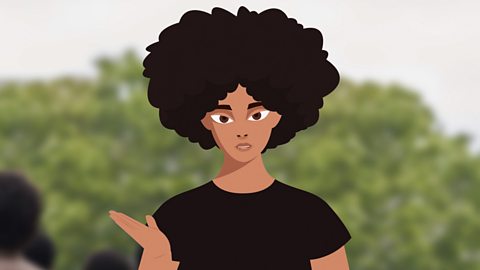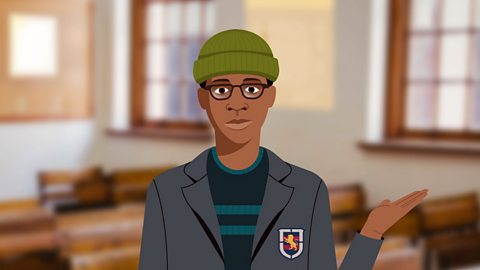Video summary
In his own words, this is story of Alex Wheatle MBE, who grew up in a children's home and later became an award-winning writer of books for children and young adults.
Alex never knew his family, who were part of the Windrush generation who migrated to Britain after World War Two. They were promised a better life, but for Alexãs family, like many others, it didnãt work out that way.
It wasn't until he left the children's home and moved to Brixton in South London that he realised how different he was. Having had little contact with other black people in the childrenãs home, at first he struggled to fit in and find his identity.
Brixton was a hotbed of racial violence in the 1980s, and mistrust towards the police was made worse after the death by fire of 13 young black people in January 1981. The incident, known as the New Cross fire, was treated as a minor fire incident by the police. No arrests were made, despite many in the black community believing the fire to have been started deliberately in a racist attack.
Tensions rose further after the police launched an operation called Swamp 81, which involved stopping and searching any young, black man within the central Brixton area. Plain-clothes officers stopped and searched 950 people in just five days, often without any reason.
On 10 April 1981, Brixton turned into a war zone. The rioting that followed over the next two days became known as the Brixton uprising.
Alex Wheatle was arrested and ended up serving time in prison. He started reading books by the likes of Chester Himes, Richard Wright, C.L.R. James and John Steinbeck, and found his passion for writing.
Teacher Notes
This short film is suitable for teaching KS3 and KS4 students. It can be used alongside the other Small Axe ôÕÑ¿èÓ Teach films or independently.
It could fit as part of a KS3 history scheme of work when looking at ãsocial, cultural and technological change in post-war British society.ã For example, it could be integrated into a scheme of working looking at social change after World War Two, migration to Britain or black British history.
At KS4, the film could be used to illustrate the experiences and treatment of migrants to Britain after the Second World as part of the AQA ãEmpire, Migration and the Peopleã course, the OCR ãMigrants to Britainã course or the forthcoming Edexcel Migration course.
Before watching the film:
Prior to this lesson you may want to introduce students to other relevant preceding events in post-war Black British history to provide context. For example:
- the arrival of the Empire Windrush in 1948
- the 1948 British Nationality Act, which conferred equal citizenship status to people in Britain and her colonies
- the Notting Hill riots in 1958 and murder of Kelso Cochrane in 1959
- Mangrove Nine case 1970-1971 (here you could use the ôÕÑ¿èÓ Teach Small Axe film)
- The Bristol St Paulãs riot in 1980
Some of your students may have read books by Alex Wheatle, who is an award-winning childrenãs author. If they have, you could ask them what they can remember from the books, their themes and if they know anything about the authorãs background.
If looking at the films as interpretations of the post-war West Indian experience, you may want to introduce the students to Steve McQueen and his motivations for creating the Small Axe collection of films. There are a number of newspaper interviews that might be helpful in providing insight.
A key part of the film are the events of 1981. You may wish to introduce students to those events ahead of the film (New Cross Fire, Black Peopleãs Day of Action and the Brixton Uprising) or use the film to introduce them.
During watching the film:
You may want to pause the video at certain points to check for understanding. Alternatively, you could wait until the end and pose questions such as:
- Why might Alex Wheatle have not learnt anything about his roots as he was growing up?
- What was Brixton like when Alex Wheatle moved there?
- How did the police treat the black community in Brixton? What were their attitudes towards them?
- What happened just before the Brixton Uprising?_
- What does the film suggest were the causes of the Brixton Uprising?
- What happened to Alex Wheatle after the Brixton Uprising? How did his life change?
- Why do you think director Steve McQueen might have chosen to make ãAlex Wheatleã as part of his Small Axe collection of films?
Following on:
You could ask students to summarise the key points of Alex Wheatleãs life. This could be done in various different ways, through storyboarding or just in bullet points. Wheatleãs life, and the events of 1981, could then act as a case study/example to illustrate experiences of West Indian migration to post-war Britain during a KS4 lesson. It should be noted that by the 1980s, many young black people had been born in Britain rather than migrating from the Caribbean.
Another potential avenue is introducing students to primary source material related to the Brixton Uprising. The Black Cultural Archives holds a range of source material, a small amount of which is online. After the Uprising, Lord Scarman was appointed by the then Home Secretary to hold an enquiry. While the Scarman Report is quite hard to get hold of online, it was debated in Parliament and parts of the transcripts could be given to students to discuss. From here you could then look at the consequences of the Uprising in the 1980s or continue the timeline up to the MacPherson Inquiry in 1998.
Students may be interested to learn that the 1981 events in Brixton are most commonly referred to as the Brixton Riots, however many people refer to them as the Brixton Uprising (as Alex Wheatle does in the film). You could ask students to consider what the different names suggest and why different groups might use them.
Alternatively, you could use Alex Wheatleãs life as a way to investigate similarities and differences in the black experience in post-war Britain. The aim of this approach would be to see both the commonalities (e.g. police harassment) and diversity (migrating to Britain vs being born in Britain). You could use people from the other Small Axe films (e.g. Leroy Logan or Althea Jones-LeCointe) to help students make those comparisons.
The Mangrove Nine. video
Rochenda Sandall, who plays one of The Mangrove Nine in Steve McQueen's Small Axe, tells the true story of this significant event in British history.

Blues Parties. video
Micheal Ward, who plays Franklin in Steve McQueen's Small Axe, explores the eruption of Blues parties in London between the 1960s and 1980s.

Educationally Subnormal Schools. video
Kenyah Sandy, who plays Kingsley Smith in Steve McQueen's Small Axe, tells the story of how hundreds of children were taken out of mainstream schools and sent to Educationally Subnormal Schools (ESN schools) in the 1970's.

Leroy Logan and the Metropolitan Police. video
In his own words Leroy Logan MBE, one of the few black police officers in the Met when he joined in 1983, narrates and shares his experiences of prejudice in the police force as portrayed in Steve McQueen's Small Axe.
